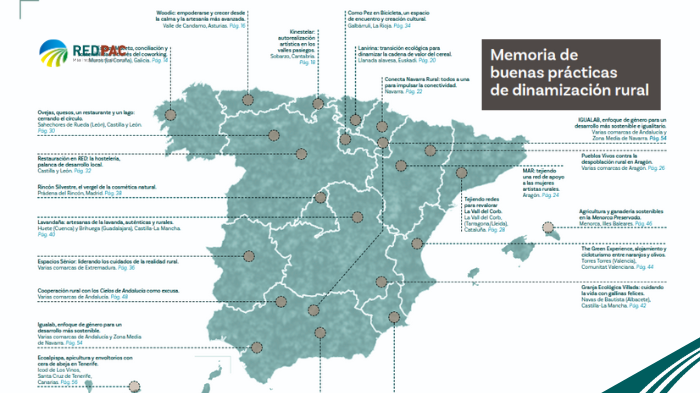
14 de November de 2024
Dinamización rural
The PAC Network publishes a "Rural Revitalization Best Practices Report" with 22 successful projects developed in the 17 Spanish autonomous communities.
- The PAC Network publishes a "Rural Revitalization Best Practices Report" with 22 successful projects developed in the 17 Spanish autonomous communities.
- We understand "good practices" as local entrepreneurship projects that solve problems or take advantage of opportunities in their territories and improve the lives of their inhabitants.
- In the case of this report, the initiatives draw on rural aid at the European level.
They have a name, a face, a voice, and hands immersed in projects working for and on behalf of the region in which they live. Activists for their people, you could say. And, for the CAP Network , they are bearers of good practices , considered those initiatives that— as defined by theEuropean CAP Network —are strategies, programs, projects, procedures, or management and implementation practices that meet the following characteristics:
- They have been tested and validated and have been implemented with positive results.
- They are successful and innovative.
- They can be developed and adapted to other contexts, that is, they are transferable.
But above all, these are actions and actions that improve the quality of life of the population, promote sustainable resource management, and promote the active participation of stakeholders. Hence, they deserve full recognition.
This is why the PAC Network has published a “Report on good practices in rural revitalization” with 22 successful projects developed in the 17 Spanish autonomous communities and financed with European agricultural and rural funds.
Project typologies
The 22 strategies compiled by the PAC Network present a huge variety of disciplines when it comes to addressing initiatives in their territories, most of them with a very clear message: to demand the right to remain with dignity in the village, or to return to it, on equal terms with urban territories, or at least to focus efforts on achieving this.
Thus, the projects deployed focus on:
- Crafts / art : among them we find Natalia Suárez and Patricia Alonso, who have proposed artistic creation and participation projects, respectively, in the Candamo Valley in Asturias and the village of Sobarzo in Cantabria. Or the Rural Women Artists collective in Aragon, a network that has strengthened its visibility and employment opportunities through this initiative, earning them the Excellence Award for Innovation for Rural Women from the Ministry of Agriculture, Fisheries, and Food in 2023.
- Scientific and technical subjects: these are the cases of Alba Fernández (architect), Natalia Díaz (biologist), and Carolina Díaz (chemist); women who, respectively, have activated the coworking services of Espazo Ma- ceta in Muros (La Coruña), or the beekeeping business in Icod de los Vinos (Tenerife), or the organic cosmetics business in the Sierra del Rincón mountain range in Madrid.
- Associations: The dossier includes the cases of Lavandaña , a perfume company from La Alcarria, founded by Mercedes de Loro and María Teresa Bermejo; a telecommunications business, Nityda Telecom , located in Balsapintada (Murcia); and an agrotourism service, The Green Experience , in Valencia. We also see the group associations of the Vall del Corb Association, which promotes the areas between Lleida and Tarragona; the Menorca Preservada program; and Aldeas Inclusiva , a non-profit organization that has been providing work for people with disabilities in the Vega de Granada region for 25 years.
- LEADER approach: The role of Local Action Groups (LAGs) in their territories is essential when supporting the development of local initiatives. This report includes examples such as the Lanirina organic wheat project in Álava, and the digital connectivity of Conecta Navarra Rural . Or the gender ( Igualab , in Andalusia and Navarre) and age ( Senior Spaces , in Extremadura) approaches to tourism for enjoying astronomy in Andalusia.
More examples can be found on the PAC Network website in the Good Practices Viewer , and initiatives deemed valid can be included upon request to the PAC Network.









